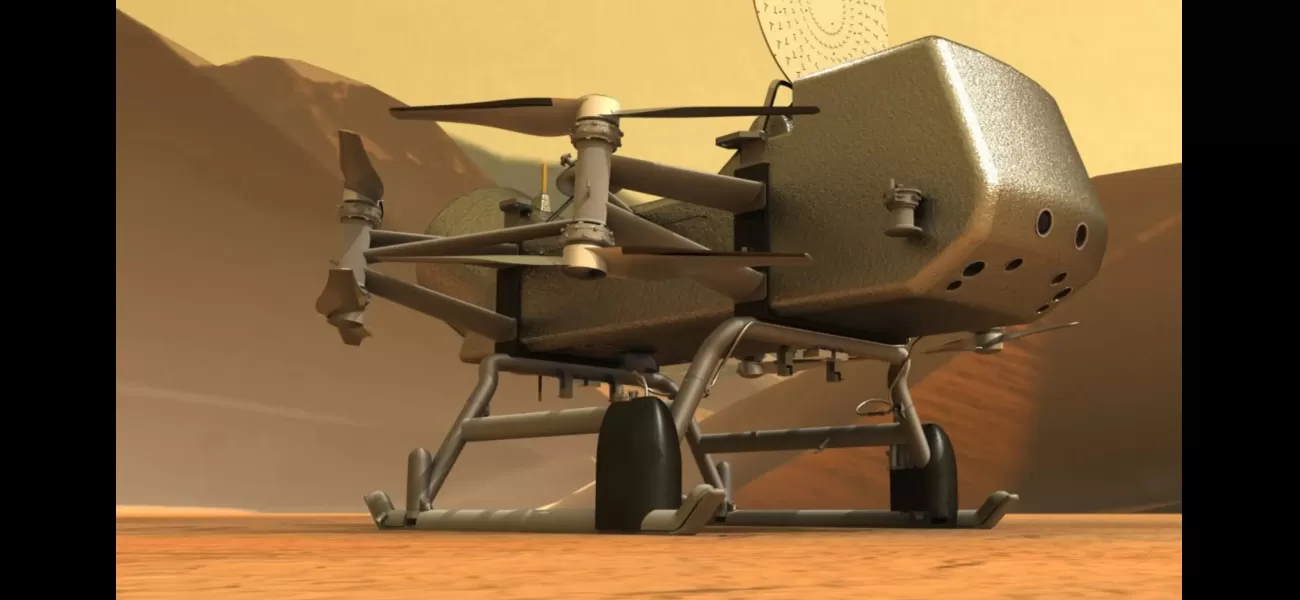Nasa's Dragonfly mission to Saturn's moon Titan costs £3.35 billion.
April 26th 2024.

Nasa has received final approval to launch its Dragonfly mission to Saturn's moon Titan, and the space agency is excited to take the next steps in this groundbreaking mission. The goal is to advance our understanding of life's origins and become the first mobile robot explorer to land on a planetary body other than the Moon or Mars. Dragonfly, a flying drone, will be the second of its kind to explore another planet, following Nasa's Ingenuity helicopter on Mars.
The mission, set to launch in July 2028, was initially planned for 2026. However, due to the need for a bigger rocket and more funding, the launch date was pushed back. The specific rocket that will carry Dragonfly to Titan will be confirmed later this year. Dr. Nicky Fox, associate administrator of Nasa's science mission directorate, expressed excitement for the mission, stating that exploring Titan will expand the capabilities of rotorcraft outside of Earth.
Dragonfly is a costly mission, with an estimated budget of $3.35 billion. The initial cost cap of $850 million was increased to $2.1 billion, not including launch or operational costs. The switch from a medium-lift to a heavy-lift launcher further added to the expenses.
Once on Titan, Dragonfly will spend at least one day at each of its intended 30 sites, gathering data and completing system checkouts before moving on to the next location. It is expected to cover a total distance of 180 km over the course of its 2.7 Earth-year mission, landing in Selk Crater.
Titan, Saturn's largest moon, is a world unlike any other. Its icy surface is covered by a golden hazy atmosphere and is the only other known world with standing bodies of liquid on its surface. With a radius of about 1,600 miles, it is almost 50% wider than Earth's moon. Light from the Sun takes 80 minutes to reach Titan, and one day on Titan is equivalent to 16 Earth days. Its atmosphere is four times thicker than Earth's.
Dragonfly is a double-rotor quadcopter with eight 1-meter long rotors and a weight of 450 kg. It will enter Titan's atmosphere using a heatshield and deploy parachutes to control its descent before landing on the surface. Once activated, it will spend the day gathering data and charging its batteries during the night to prepare for the next flight.
Nasa is excited to embark on this unprecedented investigation of Titan's complex carbon chemistry and is confident in the capabilities of Dragonfly and its team. This mission will provide invaluable insights into this mysterious moon and could potentially lead to a better understanding of the origins of life.
The mission, set to launch in July 2028, was initially planned for 2026. However, due to the need for a bigger rocket and more funding, the launch date was pushed back. The specific rocket that will carry Dragonfly to Titan will be confirmed later this year. Dr. Nicky Fox, associate administrator of Nasa's science mission directorate, expressed excitement for the mission, stating that exploring Titan will expand the capabilities of rotorcraft outside of Earth.
Dragonfly is a costly mission, with an estimated budget of $3.35 billion. The initial cost cap of $850 million was increased to $2.1 billion, not including launch or operational costs. The switch from a medium-lift to a heavy-lift launcher further added to the expenses.
Once on Titan, Dragonfly will spend at least one day at each of its intended 30 sites, gathering data and completing system checkouts before moving on to the next location. It is expected to cover a total distance of 180 km over the course of its 2.7 Earth-year mission, landing in Selk Crater.
Titan, Saturn's largest moon, is a world unlike any other. Its icy surface is covered by a golden hazy atmosphere and is the only other known world with standing bodies of liquid on its surface. With a radius of about 1,600 miles, it is almost 50% wider than Earth's moon. Light from the Sun takes 80 minutes to reach Titan, and one day on Titan is equivalent to 16 Earth days. Its atmosphere is four times thicker than Earth's.
Dragonfly is a double-rotor quadcopter with eight 1-meter long rotors and a weight of 450 kg. It will enter Titan's atmosphere using a heatshield and deploy parachutes to control its descent before landing on the surface. Once activated, it will spend the day gathering data and charging its batteries during the night to prepare for the next flight.
Nasa is excited to embark on this unprecedented investigation of Titan's complex carbon chemistry and is confident in the capabilities of Dragonfly and its team. This mission will provide invaluable insights into this mysterious moon and could potentially lead to a better understanding of the origins of life.
[This article has been trending online recently and has been generated with AI. Your feed is customized.]
[Generative AI is experimental.]
0
0
Submit Comment





